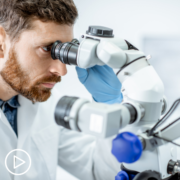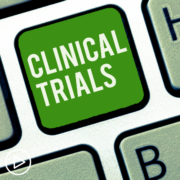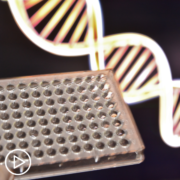Is My Myeloma Treatment Working?
Is My Myeloma Treatment Working? from Patient Empowerment Network on Vimeo.
How can a myeloma patient know if their treatment is working? Dr. Peter Forsberg explains tests involved in determining if myeloma treatment is effective and factors that may indicate that it’s time to switch therapies.
Dr. Peter Forsberg is assistant professor of medicine at the University of Colorado School of Medicine and is a specialist in multiple myeloma. More about Dr. Forsberg here.
Download Program Resource Guide
See More From The Pro-Active Myeloma Patient Toolkit
Related Resources:

|
 |

Myeloma Treatment Decisions: What’s Right for You Resource Guide |
Transcript:
Katherine:
Once a patient has started treatment, how do you know if it’s working?
Dr. Forsberg:
So, we’re lucky in myeloma in that we have some pretty easily accessible tools to evaluate how our response is going. How the myeloma is responding to treatment. How we’re sustaining that response and if we may be losing it at some point in time. And a lot of those come down to those blood tests I mentioned before.
The tools that measure protein levels or antibody levels in the blood, whether that’s intact antibodies or fragments of antibodies. So, that is that serum protein electrophoresis or serum free light chain levels.
Sometimes in conjunction with urine collections, which can measure abnormal antibodies in the urine. Those are ways that we can monitor on a month-to-month basis, how well the myeloma is responding to treatment. How well we are sustaining in a response or remission status. Or if it might be starting to come back.
We do at times use those in conjunction with other tests that look at things like bones using X-rays, MRIs or higher resolution scans like a PET scan. Or things like bone marrow biopsies which we may do at specific time points to evaluate the myeloma in different ways.
Whether that’s to evaluate a remission and see how deep that response might be, correlating it with blood work. Or if the myeloma come back, making sure we understand the characteristics of it. So, we’re lucky to be able to draw on tools that are not very invasive using bloodwork and sometimes urine. But we may couple that at certain other points in time with more substantial evaluations as well.
Katherine:
What could indicate that it’s time to switch therapies?
Dr. Forsberg:
So, the most common indicator may be a change in one of those tests that I just mentioned. If we notice that there’s an increasing level of an abnormal antibody in the blood, one that’s usually produced by the myeloma, that may be our first indicator that the myeloma has become more active and that we need to change our treatment approaches. Other times people may develop symptoms from the myeloma that shows that it is becoming active and those would be our indicators. So, those are different ways that we help to monitor the myeloma. One is assessing the bloodwork and other things that we monitor pretty closely.
The other is being vigilant for new problems that may come out. So, we end up spending a lot of time with folks over the years with the myeloma and some of that may feel a bit routine, but we’re always trying to make sure that we’re attentive to new issues as they come up.

























